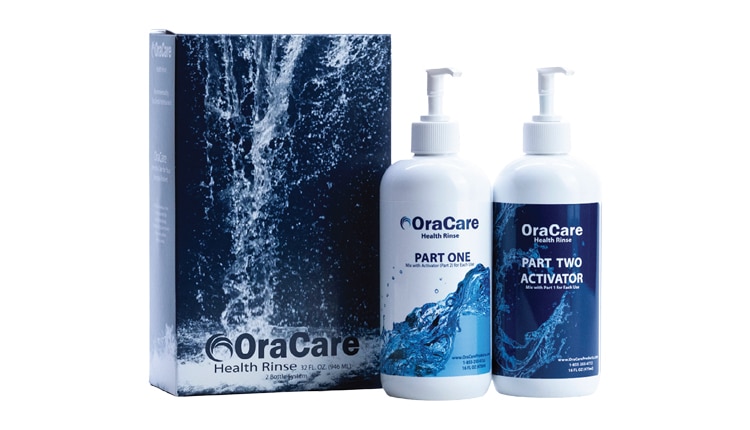Revealing the Truth About Chlorhexidine, and a Better Alternative
Exploring five myths about chlorhexidine demonstrates that OraCare rinse offers a more effective clinical alternative.
We all learned about chlorhexidine (CHX) in dental school and began using it because that’s what we were told to do. For a long time, it was the only option, but, as dentistry evolves, it’s important that we discuss the myths — and truths — about an antiseptic agent so commonly recommended by oral health professionals.
Here are five myths — and why you should consider OraCare rinse as an alternative to CHX.
Myth 1: You can use CHX long term
Truth: The recommended use of CHX is limited to two weeks. Tissue takes 30 days or more to heal, so the math doesn’t add up. After a procedure, patients need to reduce the bacteria and volatile sulfur compounds that impede wound healing for the entirety of the healing process. Use of CHX longer than two weeks will result in visible staining of teeth, as well as additional calculus buildup. Many patients find the aftertaste unpleasant. In addition, CHX takes several hours to work, so patients will have to wait before eating and drinking — which results in poor compliance. These side effects, along with the risk of allergic reactions,1 the inhibition of fibroblasts, and its poor antimicrobial capabilities, make CHX undesirable as a long-term option.2–4
Myth 2: The only problem with CHX is that it stains your teeth
Truth: Staining is the most common complaint from patients and providers. But it’s not the only side effect. Allergic reactions, while rare, are a serious risk.1 These may present as burning mouth in mild cases, but more serious reactions can be life-threatening. Importantly, CHX inhibits fibroblasts,4 and a new study notes issues with antimicrobial resistance, where the rinse itself becomes less effective and cross-resistant to other forms of bacteria.3

Myth 3: CHX is a sufficient prerinse option
Truth: There is conflicting evidence regarding CHX’s ability to reduce the oral microbial load. Studies on its antiviral capabilities show that it doesn’t kill bacteria fast enough to make it an ideal prerinse. So, if we are using it to reduce the microbial load before working on a patient, but it takes several hours to work, can that be beneficial?3
Myth 4: CHX can be used for periodontal care and implants, as well as postoperatively
Truth: This agent is only intended for treating gingivitis. While studies show CHX is an effective tool for fighting bacteria, it is nonselective in what it kills — and it has an extremely high rate of cell death of gingival fibroblasts.4 Noted for its high potential cytotoxicity, CHX impedes the healing process, which requires fibroblasts for tissue repair. We need healthy cells and fibroblasts to heal postprocedurally. Simply put, you are better off using a salt rinse or other solution than CHX.2,5,6
Myth 5: CHX is the only rinse that kills bacteria at an effective rate
Truth: The use of CHX is not the only option. We know that despite its downfalls, CHX is effective against bacteria. But when factoring in all the risks and side effects, does it make sense to keep using it? Chlorine dioxide, the active ingredient in OraCare rinse, has the power to kill the same bacteria as CHX, with the same substantivity while using less parts per million in comparison. In addition, OraCare’s ability to eliminate viruses, fungi and volatile sulfur compounds — while presenting zero side effects and improving self-care — makes it an ideal alternative to CHX.7
REFERENCES
- U.S. Food and Drug Administration. FDA Drug Safety Communication: FDA warns about rare but serious allergic reactions with the skin antiseptic chlorhexidine gluconate. Available at: https://www.fda.gov/drugs/drug-safety-and-availability/fda-drug-safety-communication-fda-warns-about-rare-serious-allergic-reactions-skin-antiseptic. Accessed June 2, 2022.
- Flemingson, Emmadi P, Ambalavanan N, Ramakrishnan T, Vijayalakshmi R. Effect of three commercial mouth rinses on cultured human gingival fibroblast: an in vitro study. Indian J Dent Res. 2008;19:21–35.
- Brookes ZLS, Bescos R, Belfield LA, Ali K, Roberts A. Current uses of chlorhexidine for management of oral disease: a narrative review. J Dent. 2020;103:103497.
- Tsourounakis I, Palaiologou‐Gallis AA, Stoute D, Maney P, Lallier TE. Effect of essential oil and chlorhexidine mouthwashes on gingival fibroblast survival and migration. J Periodontal. 2013;84:1211–1220.
- Mayo Clinic. Chlorhexidine (Oral Route). Available at: https://www.mayoclinic.org/drugs-supplements/chlorhexidine-oral-rout/side-effects/drg-20068551?p=1. Accessed June 2, 2022.
- Gupta S, Jain A, Singla M. Is saltwater mouth rinse as effective as chlorhexidine following periodontal surgery? Evid Based Dent. 2021;22:130–131.
- Downs RD, Banas JA, Zhu M. An in vitro study comparing a two-part activated chlorine dioxide oral rinse to chlorhexidine. Available at: https://www.perioimplantadvisory.com/clinical-tips/hygiene-techniques/article/16411500/an-in-vitro-study-comparing-a-twopart-activated-chlorine-dioxide-oral-rinse-to-chlorhexidine. Accessed June 2, 2022.
OraCare
855-255-6722
From Decisions in Dentistry. July 2022;8(7)20.


